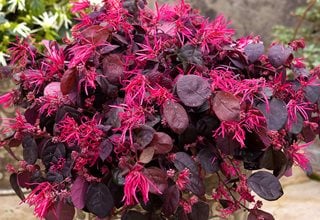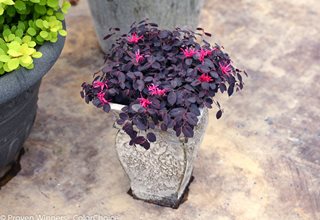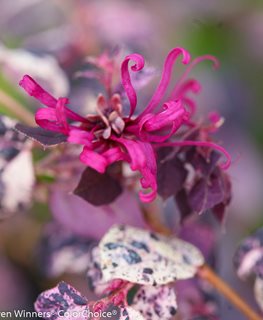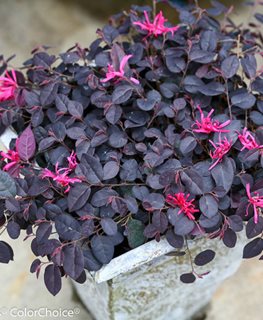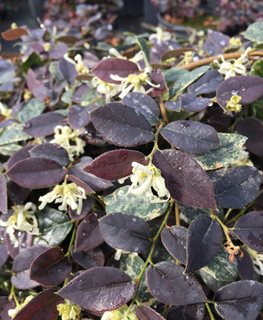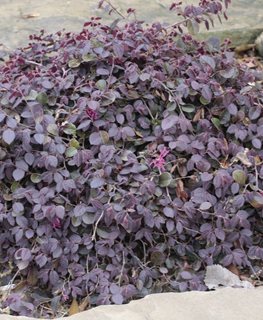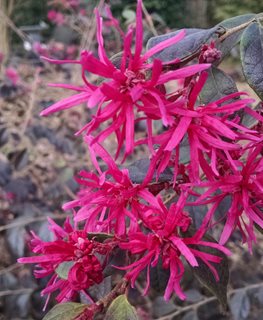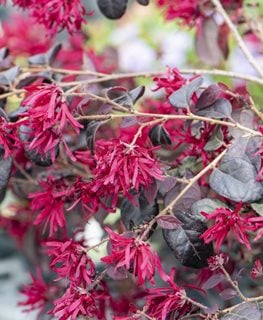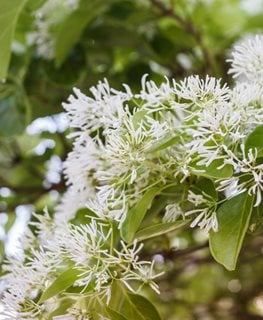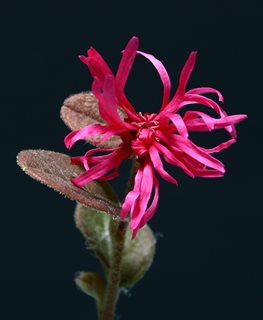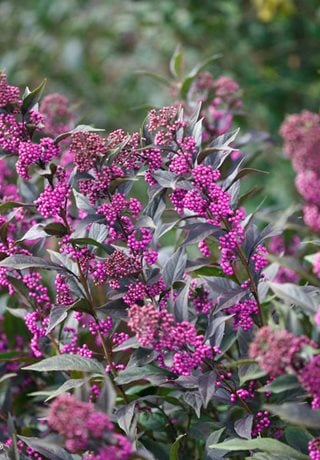GROWING LOROPETALUM - CARING FOR CHINESE FRINGE FLOWER
Evergreen foliage and dazzling flowers brighten up the landscapeChinese fringe flower (Loropetalum chinense), is an often-overlooked shrub for warmer climates. This witch hazel relative has softly crinkled evergreen foliage and profuse clusters of lightly scented, spidery flowers similar to its winter-blooming cousin. Many varieties have deep purple or burgundy leaves, a unique trait not typically seen in evergreen shrubs. Another attractive feature is its layered branching habit.
Native to woodland regions of the Himalayas, China, and Japan, Loropetalum blooms in early-mid spring, with occasional re-bloom throughout the growing season. The sophisticated appearance belies its ease of growing and virtually maintenance-free nature, making it a suitable choice even for novice gardeners. With a variety of foliage and flower colors, sizes and growth habits, this versatile shrub is a welcome addition to any style landscape.
On this page: Basics | Planting | Care | Choosing the Right Loropetalum | Pictures | Landscaping Tips
- BASICS
- PLANTING
- CARE
- HOW TO CHOOSE THE RIGHT LOROPETALUM
- LOROPETALUM VARIETIES
- LANDSCAPING & DESIGN TIPS
LOROPETALUM BASICS
Zones:
7-10
Height/Spread:
Upright, mounding, or spreading habit, 1 to 15 feet tall and 3 to 10 feet wide depending on variety
Exposure:
Full sun to light shade; bloom and foliage color is best with at least 6 hours of full sun. Provide some afternoon shade in hotter climates.
Bloom time:
Mid-spring, with some re-bloom throughout the year
Flower color and characteristics:
Tassel-like flowers with strappy, ribbon-like petals occur in prolific clusters up and down the branches. Bloom is heaviest in spring, with smaller, sporadic re-bloom at different times of the year. Flowers are lightly fragrant. Tiny, capsule-like fruits are insignificant.
Foliage color and characteristics:
This broadleaf evergreen shrub or small tree has dense branching with small, opposite oval leaves 1 to 2-1/2 inches long. Fine-textured foliage comes in shades of burgundy, purple, chartreuse and green. Mature specimens can develop exfoliating bark.
Deer resistance:
Deer may leave loropetalum alone for the most part, though regional conditions can result in deer grazing on plants that aren't necessarily their favorites.
Toxicity:
All parts of loropetalum are non-toxic to dogs, cats, and children. Ingestion of any plants can cause mild stomach upset in some pets.
PLANTING INSTRUCTIONS
When to plant:
Plant during milder months of spring or fall to avoid shock from extreme heat or cold.
Where to plant:
Grow in a sunny to lightly shaded site in a container or landscape. Plants will flower and retain color best in full sun.
How to plant:
Amend planting area as needed with compost or other rich organic matter, making sure that soil is loose and well draining. Dig a hole 2 to 3 times the diameter and slightly shallower than the size of the root ball. Tease out circling roots or slash the root ball in several places if potbound. Place in the planting hole so the top of the root ball is level or slightly above the surrounding soil. Fill in the hole with soil, tamp down gently to remove air pockets, and water well. Until plants are established, continue to water once or twice a week. Spacing depends on the variety.
LOROPETALUM CARE
Pruning:
Loropetalum looks best when allowed to grow to its full size and naturally graceful shape, though it can also tolerate heavy pruning into formal hedging or topiaries. Since loropetalum blooms on old wood, wait until flowers are finished in spring before pruning. Trim out dead and diseased branches. Lightly shape as needed, or prune to desired size and shape.
Soil:
Plant in rich, well-draining soil that is amended with compost or other organic matter. Loropetalum prefers acidic pH between 4.5 to 6.5. In alkaline soil with pH above 7.0, plants may develop chlorosis, a nutritional deficiency that causes yellowing of the leaves. Add aluminum sulfate to increase soil acidity.
Amendments & fertilizer:
Loropetalum needs little or no supplemental fertilizer once established. If desired, fertilize in spring with a slow-release all-purpose fertilizer, or one that is specially formulated for trees and shrubs. Apply according to package instructions. Mulch around the rootball with 2 to 3 inches of organic matter such as compost, straw, or aged wood chips to suppress weeds and retain moisture; avoid covering the trunk and stems with the mulch.
Watering:
Keep soil evenly moist, but not soggy. Loropetalum is somewhat drought-tolerant once established. Water more frequently during extreme heat or dry spells in summer.
Diseases and pests:
When planted in optimal conditions and properly maintained, loropetalum exhibits few, if any problems. Possible diseases include mildew, anthracnose, root rot, or bacterial gall. There are no significant pest problems, but they can be susceptible to spider mites if kept too dry or in too much sun.
HOW TO CHOOSE THE RIGHT LOROPETALUM
For borders and landscapes:
Larger, quick-growing varieties will offer maximum impact. Use as hedging, screening along a property line, as a background element in a mixed border, or massed in a bed or landscape.
For slopes and hillsides:
Select a dwarf or groundcover type that will fill in quickly, such as Jazz Hands Mini® or ‘Purple Pixie’, and mass along a bank or slope for erosion control.
For containers:
Choose a dwarf variety such as Jazz Hands® Dwarf White or Crimson Fire™ to grow in a decorative container and display in a key area such as an entryway, patio, or deck.
LOROPETALUM VARIETIES
Loropetalum alternatives:
For colder climates where lorapetalum isn’t hardy, there are other purple-foliaged shrubs that can be substituted, though they will be deciduous. These include Spilled Wine® weigela, ‘Royal Purple’ smoke bush, Summer Wine® ninebark or ‘Crimson Pygmy’ barberry.
LOROPETALUM LANDSCAPING & DESIGN TIPS
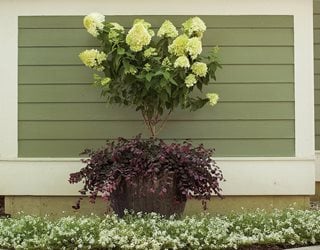
Container planting with Jazz Hands Variegated® loropetalum, 'Limelight' hydrangea,and Snow Princess® sweet alyssum beneath. Photo by Proven Winners.
There are many ways to incorporate loropetalum into your landscape. Here’s how:
- Use a larger variety as a dramatic backdrop in a mixed border, along a wall or fence.
- For a unique look, train a small-medium sized loropetalum into an espalier along a trellis or fence.
- A larger upright specimen can be trained into a small tree by removing the side branches from one or more of the main trunks as it grows.
- Mix purple-foliaged varieties, such as Jazz Hands Bold® or Purple Diamond®, with other green-foliaged shrubs or small trees to lend contrast and break up monochromatic color schemes.
- Grow a weeping form along the top of a low rock wall or on a slope to complement an Asian-style landscape.
- Plant a smaller specimen in a ceramic pot with a similar or complementary color echo and place as a focal point near an entryway.
- Plant in a woodland border in combination with regional natives for a natural landscape that supports insect pollinators and wildlife.
- Plant a dwarf form such as ‘Daruma’ in a container and group with other containerized shrubs, perennials or annuals for a year-round color display. Site in a key part of the garden such as a patio, deck or balcony.
- Plant in a mixed border or along your home’s foundation in combination with other shrubs with contrasting foliage colors of gold, chartreuse, blue, or bronze. This will make the colors stand out more against each other. Suggested companions include ‘Goldflame’ spirea, ‘Gold Mop’ cypress, ‘Kaleidoscope’ abelia or ‘Blue Star’ juniper.
Companion Plants:
Loropetalum combines well with many other shrubs, trees, and perennials. Companions can include:
RELATED:
Shrubs 101
Evergreen Shrubs for All-Season Interest
Shrubs for Shade
17 Fast-Growing Shrubs for Your Garden
15 Best Shrubs for Privacy
Growing & Caring for Witch Hazel
